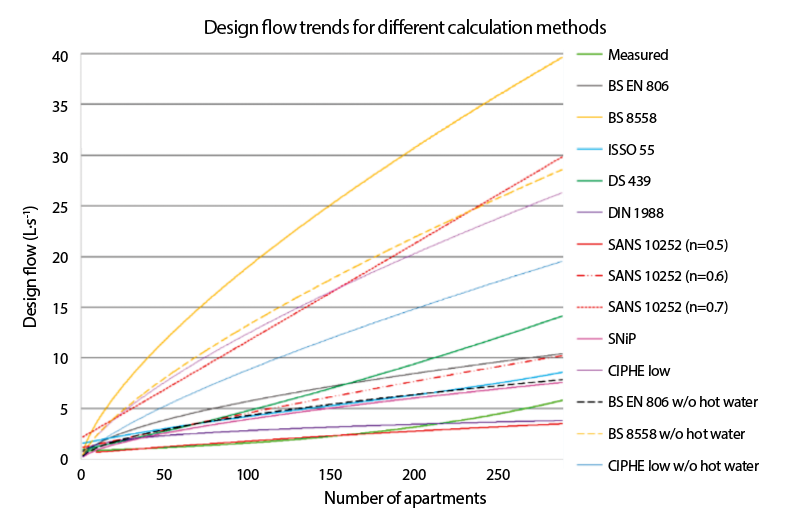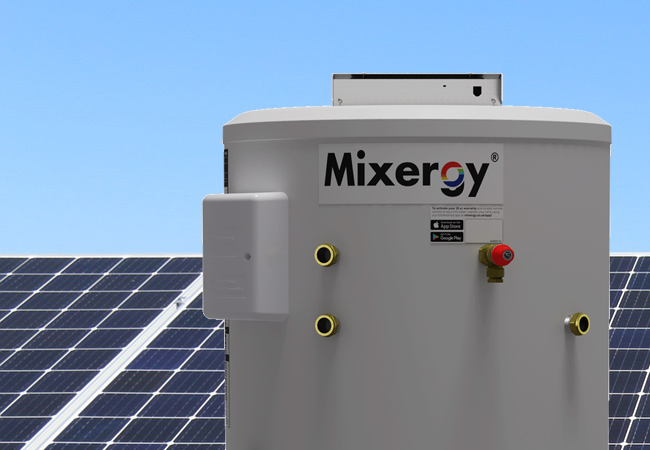
(Credit: iStock.com: Wweagle)
For many years, there has been concern that water-supply systems for buildings in the UK are being over-designed as a result of using an outdated calculation method.
The traditional loading units (LU) method is used to estimate the design water flowrate of hot and cold systems, which include pipework, booster sets and hot-water generation systems. There is evidence that using this method overestimates the design load, which leads to over-designed water-supply systems and results in larger capital costs, as well as higher energy consumption.
In addition, oversized pipework can cause lower-than-anticipated water velocities, resulting in unnecessary heat gain in cold-water pipes and heat losses in hot-water pipes. Low water velocities can also create hygiene concerns because of the risk of biofilm growth in supply systems.
While this is an issue across many building types and sizes, the impact is particularly significant in medium-to-large residential buildings.
A research initiative to address the problem – widely known within the building services industry as Loading Units Normalisation Assessment (Luna) – is now in its second phase as an Innovate UK Knowledge Transfer Programme (KTP) project between CIBSE and Heriot-Watt University. Its goal is to develop a new method for estimating the design flow in residential buildings.
Water demand for a property depends, in part, on the number of users and their water-usage patterns, which – in turn – relates to many factors, such as age, occupation, cultural background and so on.
Demand is complicated by the growth in the retrofitting of water-efficient products, such as low-flow showerheads and taps, and water-efficient toilets, which require less water. It can be seen that peak water flowrates for different apartments are unlikely to coincide because of the diversity in water usage. As a result, this has to be factored in when estimating the design water flow of a residential building with multiple apartments.
In addition, the design flow of a building differs according to the arrangement of its hot- and cold-water supply system. For example, at a given instant, the total hot- and cold-water demand at the main intake point to a building – with instantaneous heat interface units (HIUs) installed in each apartment to serve its domestic hot water demand is different from that value – if the domestic hot water demand of each apartment is served directly from a central plant room.

Figure 1: Luna phase 1 showed that all the methods used in the UK overestimate the design flowrate, some significantly
It is not economical to design the water-supply system for a possible maximum simultaneous flow, as the probability of its occurrence will be very small. So it is necessary to define a design condition with an acceptable level of system failure – calculation methods are often necessary for this task.
In the UK, the recognised standard for estimating the design flowrate in water supply systems is BS EN 806-3:2006, the UK version of the harmonised European Standard. BS 6700, which has now been replaced by BS 8558, is also a widely recognised standard within the industry.
In addition, the Plumbing Engineering Services Design Guide, published by the Chartered Institute of Plumbing and Heating Engineering (CIPHE), offers an opportunity to estimate the design flow for three frequencies of water usage; the ‘low’ usage scenario has been recommended for residential buildings.
These standards are all based on the ‘LU method’, whereby each type of appliance is assigned a LU value based on its relative load-producing weight, which depends on the flowrate of the appliance, duration of a water-use event, and the time between successive water-use events. These standards take 99% as the design condition, meaning there is a 1% chance of the actual demand exceeding the system capacity.
The task for Luna phase 1 – a joint project between Heriot-Watt University, CIBSE and CIPHE – was to recommend the most appropriate approach for estimating the design flow in residential buildings. This work compared LU-method-based UK standards with a number of shortlisted international standards. Design flow estimates calculated in accordance with these standards for as-installed designs were compared with actual flow data collected from a third party. It was clear from the results that all methods used in the UK overestimate the design flowrate, some significantly (see Figure 1).
Based on these results and a comparison of the statistical validity of these methods, Luna phase 1 proposed the development of a new method of estimating design flowrate, rather than rework the traditional LU method. (For more information on Luna phase 1, see the report here ).
The research team at Heriot-Watt University and CIBSE, led by Professor Lynne Jack, is now working on Luna phase 2, collaborating with the Luna steering group, the Society of Public Health Engineers (SoPHE) and CIPHE to propose a new methodology for estimating the design flow in medium to large residential buildings.
To develop and validate the new method, it is necessary to collect primary data representative of the peak water demand. So the research team is now looking for support from the building services and public health engineering sectors to collect data – either existing, measured hot- and cold-water flow data from residential properties in the UK – or to gain access to properties to carry out flow measurements using non-intrusive metering.
Alongside this, information on the plumbing system layout, water-using appliances and occupancy level of the building during flow measurements are required to correlate them to the relevant model variables.
The data-collection phase of the project will run until October. Anyone willing to support the work within this timescale can contact the research team on +44 (0)208 772 3626 or via email at awickramasinghe@cibse.org
The outcome of Luna phase 2 will inform technical guidance documents and, potentially, form the basis for a new standard – which should lead to more accurate specifications. This should help avoid excess energy consumption and unnecessary heat loss, and lower costs for water-supply systems in residential buildings.
■ Achala Wickramasinghe is KTP associate at Heriot-Watt University




